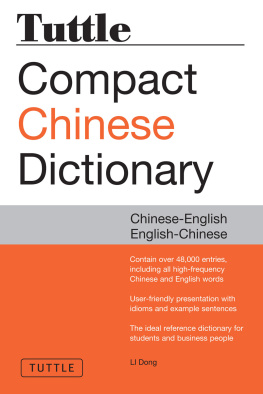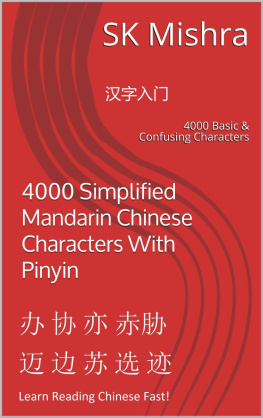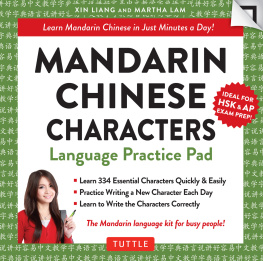Studies of the Weatherhead East Asian Institute, Columbia University
The Studies of the Weatherhead East Asian Institute of Columbia University were inaugurated in 1962 to bring to a wider public the results of significant new research on modern and contemporary East Asia.
The Chinese Typewriter
A History
Thomas S. Mullaney
The MIT Press
Cambridge, Massachusetts
London, England
2017 Massachusetts Institute of Technology
All rights reserved. No part of this book may be reproduced in any form by any electronic or mechanical means (including photocopying, recording, or information storage and retrieval) without permission in writing from the publisher.
This book was set in ITC Stone Sans Std and ITC Stone Serif Std by Toppan Best-set Premedia Limited. Printed and bound in the United States of America.
Library of Congress Cataloging-in-Publication Data
Names: Mullaney, Thomas S. (Thomas Shawn), author.
Title: The Chinese typewriter : a history / Thomas S. Mullaney.
Description: Cambridge, MA : The MIT Press, [2017] | Series: Studies of the Weatherhead East Asian Institute, Columbia University | Includes bibliographical references and index.
Identifiers: LCCN 2016050197 | ISBN 9780262036368 (hardcover : alk. paper)
ISBN 9780262340762
Subjects: LCSH: Typewriters, Chinese--History. | Typewriters--History. | Chinese language--Writing--History. | Written communication--Technological innovations--China--History. | Information technology--China--History. | Communication and technology--China--History.
Classification: LCC Z49.4.C4 M85 2017 | DDC 681.61--dc23 LC record available at https://lccn.loc.gov/2016050197
ePub Version 1.0
Per Chiara
Chinese characters are innocent.
Zhou Houkun
1915
Acknowledgments
What is your problem? Out of all possible questions you could be asking in this life, which one defines the flight path of your mental holding pattern? What is the question that you are always asking, even when to others (and perhaps to yourself) you seem to be changing the subject constantly? And why this problem? To answer these questions is exhausting and wonderful. It takes everything you have.
But to the outside world, it is socially and financially essential to make this process seem orderly and composed. To seem like we have things under control. At the outset of a new project, we say what needs saying in cover letters and funding proposals, at conferences and cocktail parties. But the truth knows better. The first thousand miles are propelled by faith, not in the answer you will find, but in the joy of the labor itself, and a fragile but persistent sense that something of value awaits if only you can hold on.
Without a well-timed and balanced mixture of criticism and faith, close friends and colleagues, it is all too easy to lose touch with this inner sense. Alex Cook continues to be one of my most cherished friends. Without his insight, kindness, and sobering humor, I have no idea where Id be. I also wish to express my gratitude to Matt Gleeson, who is not only a dear friend, brilliant writer, and longtime music partner, but also the most talented developmental editor Ive ever worked with. As before, I thank Mattie Zelin for her continued support and mentorshiponce your advisee, always your advisee. And I thank my families, both by kinship and by kindred spirit: Tom, Merri, Sonia, the late and beloved Giancarlo (IK3IES), Speranza, Scott, Mojgan, Cameron, Laura, Samantha, Mario, Fabiana, Alessio, Andy, Salley, Olivia, Kari, Annelise, Katie, Ruben, Sarah, Dennis, and Kelley.
My colleagues at Stanford may not know this, but a substantial part of my decision to set out on this book project was inspired by informal lunchtime conversations that followed my mid-term reappointment. Senior colleagues I deeply admire took me aside and subjected my entire intellectual being to dissection and scrutiny. It was unsettling, but I like unsettling. Although the idea of the Chinese typewriter had already taken hold of me by this point, it was in large part thanks to these conversations that I decided to be true to myselfunapologetically, radically, and uncompromisingly true to that inner sense of which I just spoke.
In particular, I wish to thank the generosity and criticism of Kren Wigen, Tamar Herzog, Paula Findlen, and Matt Sommeryou have been harbormasters to me, helping me navigate the unseen mountain ranges that lie beneath the surface. Thank you also to Gordon Chang, Londa Schiebinger, Robert Proctor, Zephyr Frank, Jessica Riskin, Steve Zipperstein, Estelle Freedman, Richard Roberts, and Fred Turner for innumerable hallway conversations you likely dont remember (but which I will not forget). Thank you as well to Jim Campbell for inspiring me to try my hand at curating an exhibition, and to Becky Fischbach for showing me how its done. I am also deeply grateful to intellectual fellow travelers Miyako Inoue, Yumi Moon, Jun Uchida, and Matt for reading the full early draft of this book, as well as to Haiyan Lee and Monica Wheeler. I am deeply thankful to my students as well, for this project particularly Gina Tam, Andrew Elmore, Ben Allen, and Jennifer Hsieh.
Archivists and librarians are the very best of humanity and of the academy. There should be a bank holiday just in their honor. I cannot hope to repay my debt, both in general and in particular, and so allow me instead to offer thanks to Zhaohui Xue, Regan Murphy Kao, Grace Yang, Charles Fosselman, Jidong Yang, Lisa Nguyen, Hsiao-ting Lin, and Carol Leadanham at Stanford University; Liwei Yang and the late Bill Frank at the Huntington Library, Jacques Perrier at the Muse de la Machine crire, David Baugh at the Philadelphia Records Office, Ann Marie Linnabery at the Niagara County Historical Society, Cyrille Foasso at the Muse des Arts et Mtiers, Trina Yeckley and Kevin Bailey at the National Archives and Records Administration, Ulf Kyneb and Anette Jensen at the Danish National Archives, Taos-Hlne Hani at the Bibliothque Nationale de France, David Kessler at the Bancroft Library, Rene Stein at the National Cryptologic Museum, Enrico Bandiera, Arturo Rolfo, and Marcello Turchetti at the Archivio Storico Olivetti, Maria Mayr at the Mitterhofer Schreibmaschinenmuseum, Nancy Miller at the University of Pennsylvania Archives, Wang Hsien-chun at the Academia Sinica, Craig Orr, Cathy Keen, and David Haberstich at the Smithsonian Institution, John Moffett at the Needham Research Institute, Stacy Fortner at the IBM Corporate Archives, Diane Kaplan at the Yale University Library Manuscripts and Archives division, Ben Primer at the Princeton University Library Rare Books and Special Collections, Geoff Alexander at the Academic Film Archive of North America, John Strom at the Carnegie Institution, Patrick Dowdey at Wesleyan University, Thomas Russo at the Museum of Business History and Technology, Jan Shearsmith at the Museum of Science and Industry, Alan Renton and Charlotte Dando at the Porthcurno Telegraph Museum, John Hutchins at the Machine Translation Archive, G.M. Goddard at the University of Sheffield, Charles Aylmer at the Cambridge University Library, Deb Boyer at PhillyHistory, Lucas Clawson and Carol Lockman at the Hagley Museum and Library, Frank Romano at the Museum of Printing, Ming-sun Poon at the Library of Congress, Donna Rhodes at Pearl S. Buck International, Henning Hansen in Copenhagen, Rolf Heinen in Drolshagen, Victoria West at the V&A Archive, Rory Cook at the Science Museum (London), Remi Dubuisson at the United Nations Archive (New York), Sherman Seki at the University of Hawaii at Manoa, Rebecca Johnson Melvin at the University of Delaware, Jim Bowman at FEBC International, Myles Crowley at MIT, Katherine Fox at the Harvard Business School, Raymond Lum at Harvard University, Paul Robert at the Virtual Typewriter Museum, Dag Spicer, Hansen Hsu, David Brock, Marguerite Gong Hancock, and Poppy Haralson at the Computer History Museum, and colleagues at the Beijing Municipal Archives, the Shanghai Municipal Archives, the Shanghai library, the Tianjin Municipal Archives, Tsinghua University, and Fudan University. Given the state of affairs in Chinese archives at present, and the sensitivities surrounding access and personnel, I opt not to list your names.










